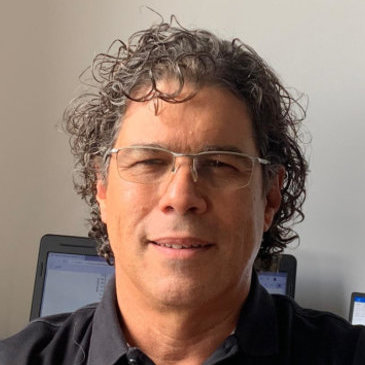Q&A: How PIT Can Improve
Natural Disaster Risk Management
Climate Change
September, 2023

Author: Carlos Genatios, Ph.D. is Director of Engineering and Technology at Miami Dade College. An expert in natural disaster risk management and reduction, he has worked with governments and researchers across the Americas for over thirty years. He founded and directs a unique community awareness and workforce development program at Miami Dade, Geographic Information Systems for Environmental Awareness and Community Engagement (GISEC) .
Professor Genatios sat down with PITUNiverse Editor Kip Dooley to discuss how Miami Dade College is applying the tools of public interest technology to improve disaster response tools for communities vulnerable to climate change.
Carlos Genatios: I’m a structural engineer, an earthquake engineer by study. I’ve been working in natural disaster risk reduction for more than 30 years now. I have been a professor of civil engineering at the Universidad Central de Venezuela, served as Venezuela’s minister for science and technology, and have consulted for many years with large institutions like the Inter-American Development Bank (IADB) and the UN. I’ve collaborated with stakeholders across borders on Latin American associations for disaster risk reduction, delivering public resources like codes and solutions for communities and governments to prepare for and respond to natural disasters.
I moved to the United States almost 10 years ago and continued working in the area of natural disaster risk reduction. In Miami, we don’t have earthquakes, but we do have hurricanes. The methodologies for studying and mitigating their impacts are similar. At the same time, Miami is vulnerable to rising sea levels caused by climate change, increasing the risk and impact of natural disasters, so the work is becoming more and more urgent.
When I began working at Miami Dade College five years ago, one of my main goals was to create programs that focus on solving public interest issues and connect students to career opportunities. I decided to create a program based on geographic information systems (GIS), that teaches students about working in natural disaster risk reduction and generates community outreach to inform families of potential dangers
What is the student body like at MDC, and how do you engage students through the GIS program?
At Miami Dade, we work hard to make sure our students can achieve their goals and build careers in their chosen field. Miami Dade has over 100,000 students enrolled; many are first-generation students and over 80% of students are minorities. Of all U.S. colleges and universities, we enroll the most Hispanic undergraduate students, and we are third in Black non-Hispanic undergrad enrollment. We have a great opportunity to cultivate a diverse cohort of technologists, who come from communities historically excluded from technology design.
With the GIS program we’ve focused on student professional development in a few ways. First, we created the GIS Pathway, a 21-credit College Credit Certificate (CCC) in GIS that helps students from any discipline gain experience with GIS systems—a requirement for many jobs in this field.
Second, we created a dual enrollment articulation open to high school students, so they can take courses on campus and even complete the full CCC. The credits are transferable to an associate’s degree and a bachelor’s degree.
Sometimes I just call this educational program not a pathway, but a highway. It offers students a direct channel to well-paying jobs. And if they are interested and able to go further with their formal education, they can continue studying with us and taking more courses toward a full degree, and even continue on to graduate courses and certificates.
How does the program work to reduce disaster risk in the local community?
We start by using some of the methodologies developed by the Federal Emergency Management Agency (FEMA) to assess risks and inform local and federal government decisions. And then we work to improve these methodologies.
Existing FEMA frameworks mainly use census tracts or census blocks to determine risk and the expected potential losses during a natural disaster. For example, if we analyze the hurricane hazard in a given timeframe—let’s say in the next 20 years—what are the probabilistic expected losses, the economic and social losses, in a particular area?
Unfortunately, these models are not very accurate, mainly because they rely on averages. As a result, the poorest people are often left behind, because the models lose sight of those who are suffering most. While some rich people are also left out of these models, we choose to focus on the poorest people who have the largest problems, because poverty is already a disaster. When a natural disaster strikes, the poorest people are the ones who suffer the most and struggle the most to recover.
So you’re actually building on and improving the models used by the public institutions responsible for supporting people in the wake of disasters. What other data do you collect in order to do this?
We go to where the people in need are. We use technology like drones to visit and model areas, including low-income and low-wealth areas, and we gather existing GIS data from towns and counties. We then compare this data with national-level data that FEMA is using, and also with publicly available county level data. Often, we find significant differences between our models and FEMA’s. We have found that the risk is sometimes two or three times greater than what existing models predict.
We have also developed some simplified methodologies to assess social vulnerability, because we need to have an idea of the expected losses beyond just the immediate impact of a hurricane. For example, if you have a home in a given area, what are the potential losses in your home value? What are the odds you will lose 10% of your home value? 20%? 30%? And, how vulnerable and resilient are you to withstand those losses?
In our assessments, we also include other results that FEMA’s models deliver- factors like job loss. If people lose their jobs due to a natural disaster, what are the consequences? How long will it be until they find another job? It could take years, which is a lot of lost income. You have to take those factors into consideration as well.
Social losses include things like the number of deaths, and the number of shelters needed in the wake of a disaster. Models need to incorporate the impact of disasters on the social side of human life, our relationships and connection to community, which is just as important as meeting peoples’ basic physical needs.
And of course there are the physical losses: How many homes are likely to be destroyed altogether? How many roofs are going to be lost? What has to be done to reinforce them? We also analyze the debris that’s generated, and how many trucks will be needed to remove all the debris.
How do you then bring your findings back to the communities you’re assessing?
We take this information and try to deliver it to people in the communities through formal education (credited and noncredited) and through partnerships and consultancies, so they can really understand what the risk factors are and plan mitigation and adaptation actions.
There are a number of limitations that we have to deal with. In poorer communities, people understand the need to mitigate natural disaster risk but often lack the funds to do so—not to mention they are already dealing with multiple current crises, so it’s difficult to focus and prepare for future ones. On the other hand, communities that do have resources often contract with large companies that use models that don’t necessarily provide a full picture and that can leave out the poorer communities. We are working to find the right community partners to develop consultancies with; the PIT-UN Challenge Grants have enabled us to lay the foundation so far.
How can other schools and students not at MDC engage with the GISEC program?
It’s a program that can be replicated by anybody, anytime, at any college. I actually think all community colleges should have this kind of program, because all over the U.S, communities have natural disaster risks, whether that’s earthquakes, hurricanes, tornadoes, or fires, like what recently happened in Hawaii.
We have created free online courses so students and community members anywhere can learn about GIS. This year, we’re delivering three free online courses: GIS Mapping, Drone to Map and Flooding Simulation and Analysis.
We already held one course in GIS that enrolled 45 students and had a long waitlist. Our courses are first offered to students at Miami Dade College, then PIT-UN member students, and then to organizations in the EU and Latin America, Europe and beyond. Right now in the Drone to Map course, we have students from East Africa, Italy, and five Latin American countries. I think interest in the program is growing, and we really want to continue growing the work, making this accessible for more people and humanitarian organizations.
What are the next steps for growing the GISEC program?
As I mentioned earlier, GISEC is currently working toward finding communities that we can partner with to assess and contribute to address local natural disaster risks. Ideally, one of our options is to partner with communities that have the resources to pay for and implement consultancy recommendations. In turn, these funds could be used to support work in communities without resources. We are also looking for partners and funding institutions that can support our effort to make the underrepresented people more visible, and better prepared. This project needs to expand beyond the walls of the college.
All these environmental risk analysis efforts not only support the assessment of potential losses; they also deliver data, knowledge, and capacities to build adaptation and mitigation plans. These forward-looking plans are fundamental for decision-making in risk reduction, while also producing a platform for attention to emergencies.
Since our models take into account additional factors that are not in current FEMA risk analysis models, with a bit more development our models could be used by insurance companies to provide more precise disaster coverage. So, this would be a product outcome from our work: a tool that can be leveraged by the private sector. As an example, we are studying the corrosion behavior in coastal buildings and how this factor increases risk over time.
In addition, we are hoping to expand our work with partners outside of the U.S. In several European countries, property documents include a report on the risks of the dwelling. Additionally, many countries are starting to use blockchain for contracts related to building construction and leasing. I think that in the future it will be standard practice to include risk values in all property documents. Blockchain systems have the potential to make the risks about properties transparent to potential buyers, and that’s an area we are beginning to explore.
Depending on our future community partners and clients, GISEC is opening its path to expand into a non-profit or LLC for environmental risk and disaster mitigation that includes a focus in low-income areas. We plan to call it Environmental Risk and Resilience. There are a lot of possibilities in education, environmental risk awareness, and community engagement for disaster risk reduction, and we are committed to making our contribution.
